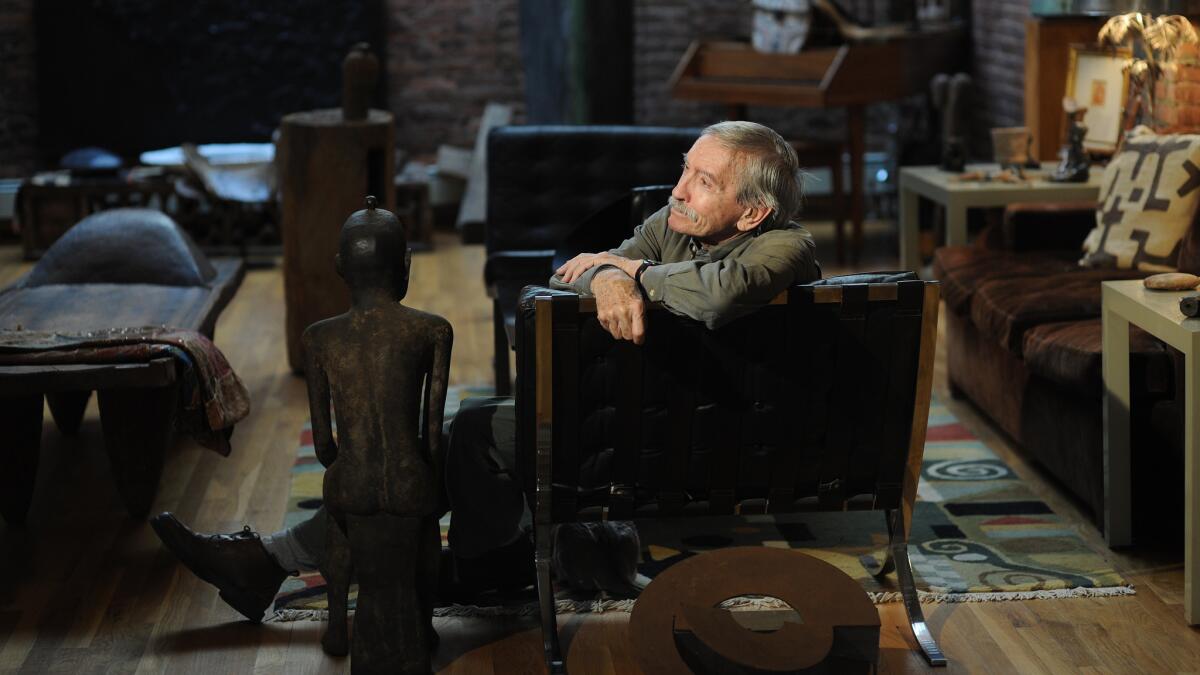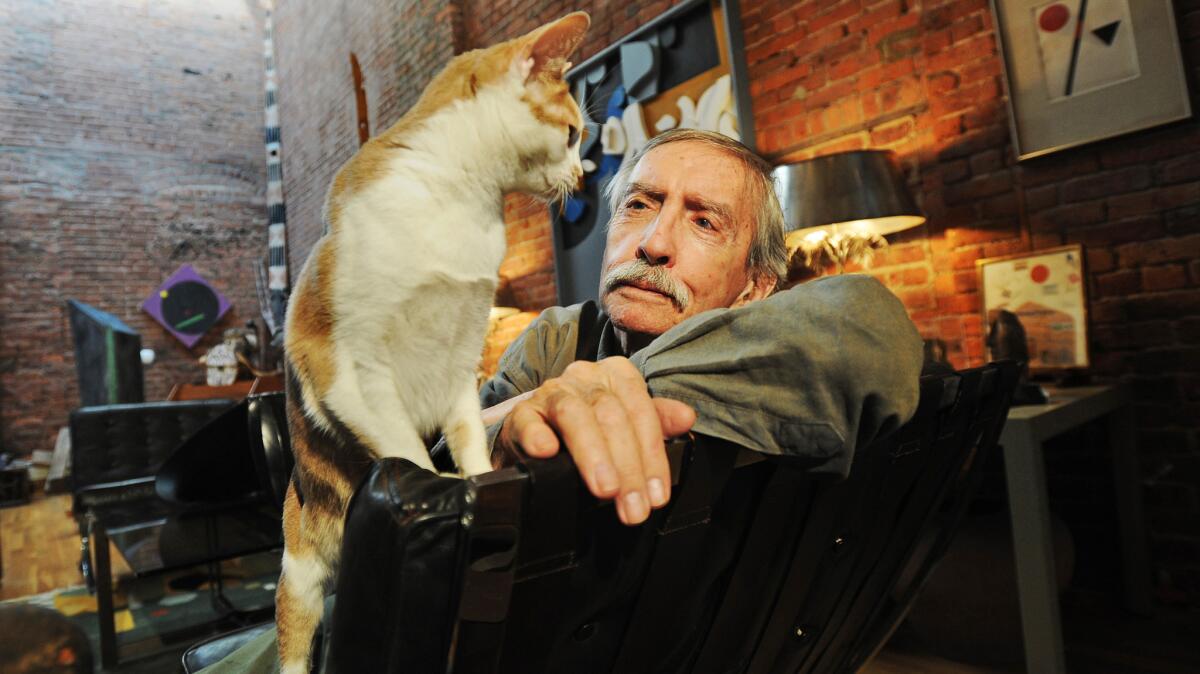Appreciation: The genius of Edward Albee and the inner voice that brought difficult truths to the stage

- Share via
David Mamet once described two of New York’s leading drama critics as the syphilis and gonorrhea of the American theater. Edward Albee, whose death at age 88 on Friday marked the end of his reign as the greatest living American playwright, chiseled his own choice invectives for reviewers over his topsy-turvy career.
As a playwright who was both heralded as the Second Coming and derided as the Anti-Christ, he knew all too well the dangers of paying too much attention to outside verdicts. This stance was as much a carapace for artistic survival as it was a principled position against those forces arrayed against the individual talent.
“The playwright, along with any writer, composer, painter in this society, has got to have a terribly private view of his own value, of his own work,” Albee told the Paris Review while still in his early prime. “He’s got to listen to his own voice primarily. He’s got to watch out for fads, for what might be called the critical aesthetics.”
Reputations, he knew, were built up only to be torn down: “A lot of playwrights become confused by this and they start doing imitations of what they’ve done before, or they try to do something entirely different, in which case they get accused by the same critics of not doing what they used to do so well.”
SIGN UP for the free Essential Arts & Culture newsletter »
Theater’s connection to the marketplace is part of its glamour but Albee recognized that it was also one of its traps. In fighting against the stultifying narrowness of the commercial theater, Albee was simultaneously fighting for his fellow playwrights and theater artists, many of whom owe him a great debt for the moral and financial support he provided through his friendship and foundation.
He leaves behind a valuable trove of plays — two that I would call masterpieces (“The Zoo Story” and “Three Tall Women”), one that will never relinquish its place in the theatrical repertoire (“Who’s Afraid of Virginia Woolf?”) and a half-dozen richly provocative dramas that will continue to rise and fall with critical fashions. In the right hands, the many baffling other works may yet yield up their reluctant magic.
Albee is the bridge between the great American dramatists who preceded him (Eugene O’Neill, Thornton Wilder, Tennessee Williams and Arthur Miller) and the generation that came after that includes Sam Shepard and Mamet. When asked about his influences, Albee once piquantly paired Sophocles and Noël Coward, and his work can be seen as a unique blend of tragic vision and hyper-articulate wit. But the writer he admired most was Samuel Beckett, who provided a model for the fusion of uncompromising form and unsparing content.
Martin Esslin, author of the influential book “The Theatre of the Absurd,” designated Albee an American member of the club that had formed around the Irish playwright. Albee was wary of these classifications, seeing them as artistic straitjackets. He knew the “absurdist” label papered over the manifold differences of writers who hadn’t really all that much in common. Yet he couldn’t help being inspired by the modernist revolution that was overturning the hidebound rules of the contemporary stage.
In his 1962 essay “Which Theatre Is the Absurd One?” (originally published in the New York Times Magazine), Albee voiced his reservations about his induction into the Theater of the Absurd. But he also quoted lines from Esslin that felt congenial to him at the time and which now brilliantly illuminate his work:
Ultimately, a phenomenon like the Theatre of the Absurd does not reflect despair or a return to dark irrational forces but expresses modern man’s endeavor to come to terms with the world in which he lives. It attempts to make him face up to the human condition as it really is, to free him from illusions that are bound to cause constant maladjustment and disappointment. … For the dignity of man lies in his ability to face reality in all its senselessness; to accept it freely, without fear, without illusions — and to laugh at it.
Albee offered an “Amen” to these sentiments. A few years later he would crystallize the themes in “A Delicate Balance,” his drama about a prosperous American family beset with existential panic after a years of repression, booze and bad faith. “A Delicate Balance” was the first of his three plays to win the Pulitzer Prize; “Seascape” was the second and then, after a long gap in which nearly everyone had written him off, “Three Tall Women” was honored, lending momentum to his flourishing late career.
When I interviewed Albee in his art-filled Tribeca loft in 2009, I entered with some trepidation. He was infamous for his prickliness and sharp tongue, and I had written an admiring but tough assessment of his oeuvre a few years earlier for the Village Voice when his play “The Goat or, Who Is Sylvia?” was on Broadway. My conclusion was that Albee’s theatrical instincts were far superior to his philosophical abilities, and that the symbolic architecture of his plays was often a distraction from the animating dramatic wound caused by the collision of cruelty and kindness — or what Jerry from “The Zoo Story” refers to as “the teaching emotion.” Here is where, I argued, the heart — and genius — of his plays lie.
Fearing that I was going to be scolded for my erroneous insights, I found myself devoting my introductory pleasantries to an adorable part-Abyssinian cat. Before I knew it, I was on the floor making friends with this flirtatious feline to Albee’s delight.

There could not have been a better icebreaker. Albee was a great animal lover — a sadness washed into his eyes when he told me as I was leaving about a cat that fell down the elevator shaft and died — and his plays are a virtual menagerie, populated with pets, barnyard creatures and, of course, those lizards from “Seascape.”
I asked him about the recurring figure of a lost or imperiled child in his plays — a topic I had hoped might launch us on a psychoanalytic stroll into his difficult childhood as the adopted son of a wealthy but evidently chilly suburban New York couple. But Albee thought it might be more productive to consider the way animals in his plays offer human beings a unique reflection of their condition.
He cautioned me against trying to discern his sensibility in his art collection, which consisted mostly of African sculpture and 20th century European and American paintings. But his appreciation for vision playfully transmuted into objective form was palpable. For Albee a play wasn’t a representation of life but life itself, an addition dreamed up by a writer with time and talent to turn mental image into creation.
No one thinks of Albee as a naturalistic writer, but he always insisted that the actions that take place on his stage, no matter how extraordinary, were as real as the refrigerator in your kitchen. He saw his plays, in effect, the way an actor must approach them — as situations to be inhabited. Realism is in the eye of the beholder.
Great performers are drawn to his plays for their eloquent humor, eccentric freedom and feverish pursuit (and avoidance) of buried truth. These dramas might seem artificial, as “All Over,” a deathbed vigil played out as a concert of aggrieved voices, can seem. But there was nothing at all unnatural about director Emily Mann’s superb 2002 revival. The cast included an astringently sublime and ultimately heartbreaking Rosemary Harris and a marvelously cantankerous Myra Carter, two of Albee’s most agile interpreters whose secret was treating every moment as though it were as strange and familiar as the workaday world.
At an awards panel lunch, Marian Seldes, another brilliant Albee player, once explained in a discussion of an iconoclastic work that a playwright creates a universe and gives that universe a language all its own. I thought of Shakespeare’s line in “A Midsummer Night’s Dream” about the way a poet’s pen “gives to airy nothing/a local habitation and a name.” But even more I thought of Edward Albee and the way his plays have tilled the cultural soil for a wider acceptance of the dreamlike reality of this living art form.
Follow me @charlesmcnulty
ALSO
Obituary: Edward Albee, three-time Pulitzer-winning playwright, dies at 88
2009 interview: Edward Albee, part-time pussycat
Appreciation: The theater world’s loss of Myra Carter, Brian Bedford and Alan Rickman resounds
More to Read
The biggest entertainment stories
Get our big stories about Hollywood, film, television, music, arts, culture and more right in your inbox as soon as they publish.
You may occasionally receive promotional content from the Los Angeles Times.











